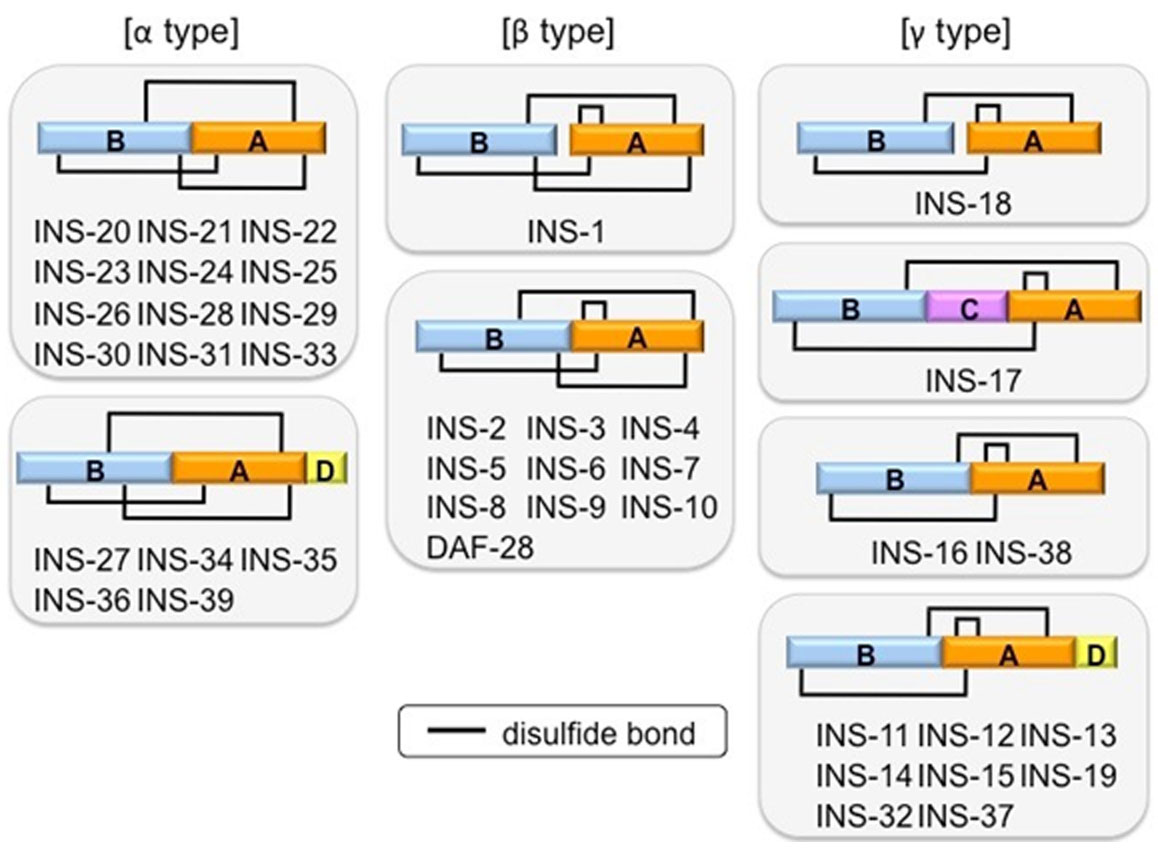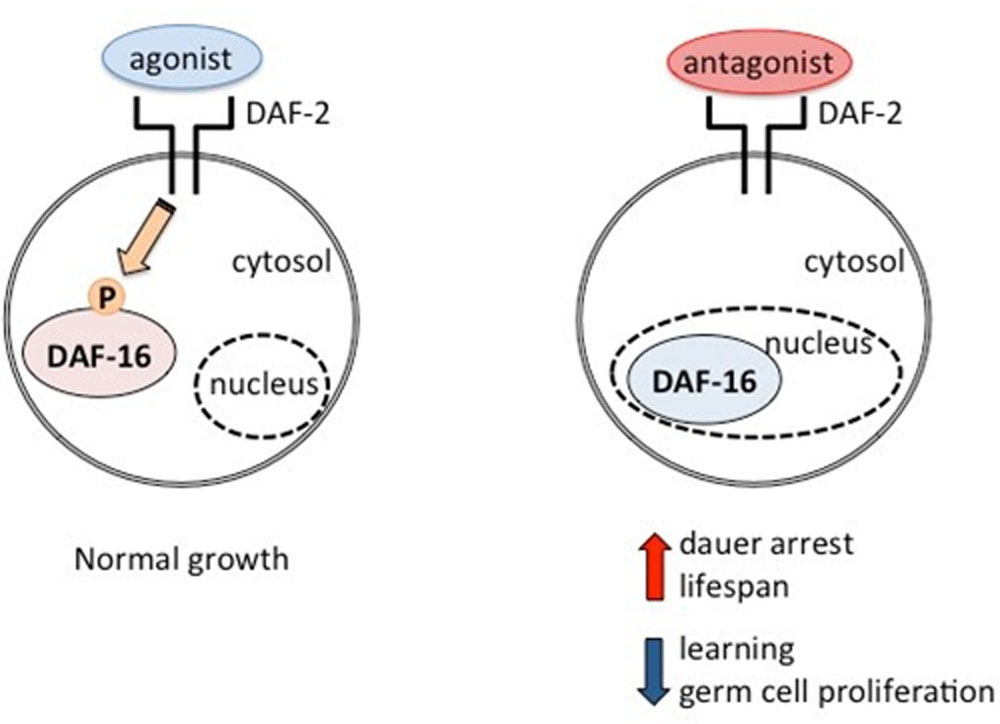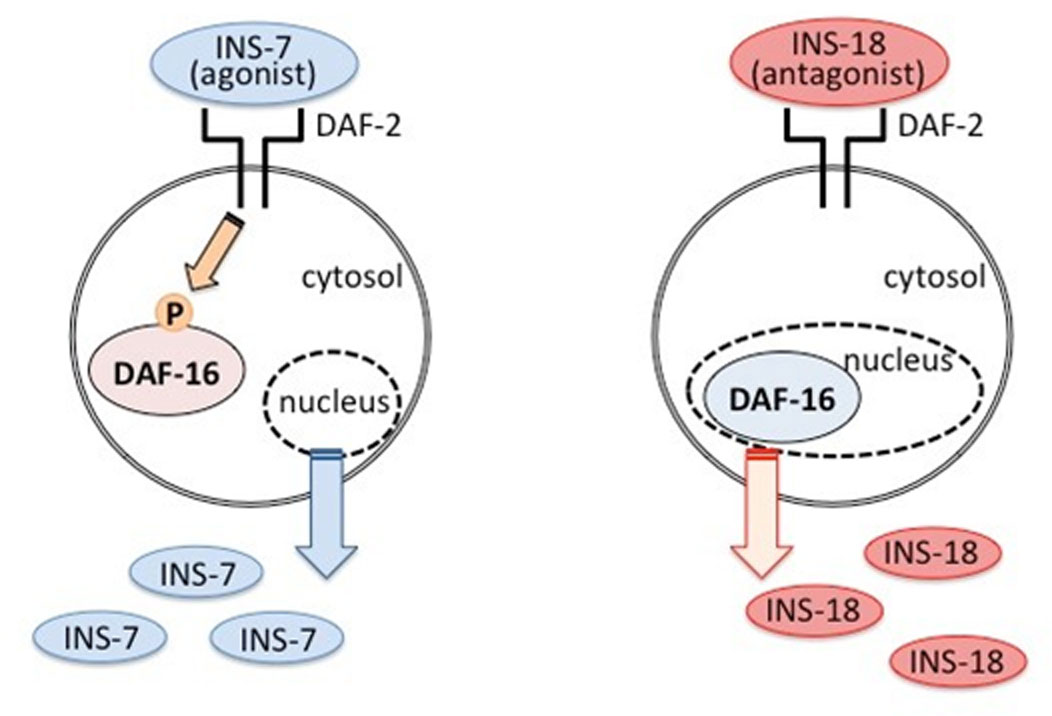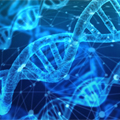1. Introduction
Insulin is one of famous peptide hormones as a modulator for blood glucose level. Insulin was discovered in 1922 [1]. After that, chemical structure and tertiary structure of insulin were resolved [2,3]. In 2006, the tertiary structures of insulin receptor (IR) and insulin-receptor complex were resolved [4]. Insulin consists of two polypeptides (B-chain and A-chain). The B- and A-chains are connected with two intermolecular disulfide bonds, and the A-chain has one intramolecular bond. The B-chain contains one α-helix and the A-chain contains two α-helices, respectively. Recently, Haeusler and co-workers have reviewed IR and insulin signaling mechanism [5]: i.e., identification, cDNA cloning, tyrosine phosphorylation, downstream components of IR (the IR substrate proteins, the phosphoinositide 3-kinase, the phosphoinositide-dependent kinase PDK, the serine/threonine kinase AKT, and the AKT's downstream targets including the forehead family box O (FOXO) transcription factor). In addition, how functions of the FOXO are regulated by AKT-dependent phosphorylation and the relevancy of FOXO to glucose production/utilization are also described (For more detail information of general insulin signaling pathway, please see Haeusler et al., 2018 [5]). The peptide hormone IGF-1 (insulin-like growth factor-1) is structurally similar to insulin. It shows more than 50% sequence similarity to insulin and its disulfide bond patter is same to that of insulin, while it consists of one polypeptide including the B-, -C, -A, and D-domains in the order. The IGF-1 has three α-helices like insulin [6]. The IGF-1 receptor has a same structure to that of IR (a dimeric transmembrane protein consisting of two α-subunits and two β-subunits) and the signaling mechanisms of these receptors are almost same to each other [7].
The insulin/IGF-1 signaling (IIS) pathway is widely conserved in invertebrates [8,9]. In particular, the roundworm Caenorhabditis elegans and the fruit fly Drosophila melanogaster have been used as popular invertebrate models for studying the IIS pathway because of their powerful genetic tools. Especially, many important findings regarding aging-IIS pathway conserved evolutionally have been raised [10,11]. These findings led to discoveries showing IIS also regulates aging in mice and humans [12,13]. Basically, these invertebrate models conserve similar pathways to human insulin signaling pathway. However, unlike human insulin signaling pathway, C. elegans and D. melanogaster have numerous putative ligands called insulin-like peptides (ILPs) for their solo receptor, which responds to all types of ILPs. In D. melanogaster, there are eight Drosophila ILPs (DILPs), which are produced in different conditions and tissues, and play diverse roles [14]. DILPs 1-8 have been identified mostly through their sequence homology to the mammalian insulin, and they have the typical B-C-A domain structure as observed in human insulin [15]. DILPs have important roles in stress resistance, development and metabolism [16,17]. In C. elegans, there are 40 ILPs, which are key regulators of stress resistance, development, reproduction, and aging [18]. Here we review the discovery of the C. elegans IIS pathway briefly, and then focus on physiological functions, secretion, and transcriptional regulation mechanism of the C. elegans ILPs.
2. The C. elegans IIS pathway
The roundworm C. elegans has been established as an excellent model for research on molecular mechanisms regulating complicated phenomena including nervous system and behavior by Brenner S [19]. C. elegans is suitable for studying regulatory mechanism of animal aging, because of its short lifespan (2-3 weeks at 20 °C) together with low cost and easy handling. The C. elegans genome sequencing has been completed in 1998 [20]. This genomic information provides a powerful resource for reverse genetics such as RNA interference (RNAi) and gene disruption methods [21,22], indicating that the C. elegans is an excellent genetic tool. age-1 was first identified by a genetic screening for long-lived mutants, and subsequent analysis suggested that the longevity phenotype in this mutant strain was due to a recessive mutation in a single gene [23,24,25,26]. AGE-1, which is a subunit of the phosphoinositide 3-kinase (PI3K), acts as a component of IIS pathway. Later, daf-2 was also identified as a long-lived mutant, and it lives twice as long as wild type animals [27]. Cloning of daf-2 revealed that it encodes a receptor tyrosine kinase that shows more than 30% amino acid identity to the human insulin receptor [28]. The extended longevity of age-1 or daf-2 mutants required daf-16 encoding a transcription factor FOXO ortholog [27,29]. In responses to harsh environmental conditions, C. elegans ceases development and forms dauer larva. Dauer larva exhibits morphological/behavioral characteristics distinct from those of developing larvae, and has stress response such as heat and drying [30]. A genetic screening for abnormal dauer formation identified several genes including daf-2 and daf-16 that are categorized into either dauer-constitutive (daf-c) or dauer-defective (daf-d) mutations [31]. Genetic analyses revealed that daf-2/daf-16 pathway also regulates dauer formation [32,33,34,35,36,37]. Therefore, DAF-16 acts as a main downstream component both in aging and dauer formation. The daf-2/daf-16 pathway also mediates cell division [38], and stresses including heat [39,40,41,42,43,44], oxidative status [45,46], hypoxia [47], osmotic pressure [48], heavy metal toxicity [49], ultraviolet radiation [29], and proteotoxicity [44,50,51,52,53,54,55] directly. Therefore, the C. elegans IIS pathway has a crucial role in the regulation of homeostasis.
2.1. The C. elegans Insulin-like peptides (ILPs)
2.1.1. Discovery
Insulin-related peptides have the same organization of their precursor proteins such as a signal peptide, a B-chain (domain), a C- peptide (domain), and an A-chain (domain), in some cases, D- and E-domains. The B- and A-chains (domains) are connected with two intermolecular disulfide bonds, and the A-chain (domain) has one intramolecular bond like insulin. These peptides have been identified in invertebrates as well as vertebrates: Bombyxins, brain secretory peptides in the silkworm Bombyx mori [56], molluscan insulin-related peptides 1-7 (MIP) [57], locust insulin-related peptide (LIRP) [58], a lobster insulin-like peptide [59] and nematode insulin-like peptides (see below).
In 1998, we explored insulin-like peptides on the C. elegans genome by genetic and bioinformatics studies, and identified two genes, ins-17 (Ceinsulin-2) and ins-18 (Ceinsulin-1), encoding putative peptides. These predicted amino acid sequences contain a signal peptide, a B-chain, a C-peptide, and an A-chain in this order and possess six cysteine residues identical with those of bombyxins and human insulin (Personal communication in Worm Breeder's Gazette 15: 47). Around the same time, Duret and co-workers have identified 10 genes encoding ILPs, and categorized these ILPs into three groups: An ILP in γ type, INS-11, has three canonical disulfide bonds (two B-A bonds between B- and A-domain, and one bond within A-domain), the same as C. elegans INS-17 and INS-18, and human insulin. Six ILPs, INS-2 through INS-7 in β type, have an additional disulfide bond between B- and A-domains, in addition to the three canonical ones. Three ILPs (INS-21 through INS-23) in α type have a different pattern of three disulfide bonds (three bonds between B- and A-domains) [60]. In 2001, Pierce and co-workers analyzed the entire C. elegans genome, and identified additional 25 candidates of insulin-like genes: ins-1, ins-8 through ins-20, ins-24 through ins-37 [61]. Later, Li and co-workers showed DAF-28, which corresponding mutant had been obtained by a forward genetic screening, functions as a ligand for DAF-2 receptor [62]. Finally, ins-38 appeared to be present in the C. elegans genome, while a novel insulin-like gene, ins-39, has been found by BLAST searches [63]. Until now, 40 ILPs (INS-1 through INS-39, and DAF-28) have been identified as putative ligands for the DAF-2 receptor, and categorized into α, β, and γ types. Thus, it is suggested that the insulin signaling pathway was already present in early stage of metazoan evolution.
2.1.2. Physiological functions
Genetic and biological studies have revealed that ILPs regulates numerous biological phenomena including dauer formation, lifespan, heat resistance, pathogen resistance, and reproduction, positively or negatively [18]. Thus, ILPs function as key regulators in IIS pathway, and several ILPs have been studied in some depth.
In the regulation of lifespan, we demonstrated that RNAi knockdown or knockout of ins-18 resulted in a decrease in extended lifespan, whereas its overexpression resulted in an extension of lifespan [64,65]. In the progress of normal aging, the expression of ins-18 decreased [66]. These studies suggest that INS-18 functions as a longevity peptide. We also found that knockout of ins-11 resulted in a decrease in extended lifespan, similar to ins-18 [67]. DAF-2, the sole C. elegans ILP receptor, phosphorylates the kinase cascade, which composes of AGE-1/PI3K, PDK-1/PDK, and ATKs (AKT-1 and -2). The cascade finally leads to the phosphorylation of DAF-16, a FOXO type transcription factor, and its cytoplasmic retention [68,69,70]. In contrast, loss of function of DAF-2 results in reduction of the phosphorylation and subsequent nuclear translocation of DAF-16, leading to an increase in lifespan extension [71,72,73]. Therefore, INS-18 and INS-11 are likely to function as negative regulators (antagonists) on IIS in the regulation of lifespan. In contrast, INS-7 and DAF-28 function as positive regulators (agonists) in the regulation [74,75].
In the regulation of dauer formation, we demonstrated that knockout of ins-17, ins-18 or ins-23 decreased in dauer formation, whereas overexpression of ins-17, ins-18 or ins-23 increased in dauer formation [65,76,77]. Moreover, Pierce and co-workers demonstrated that overexpression of ins-1 increased in dauer formation [61]. Attenuation of IIS results in nuclear translocation of DAF-16, leading to an increase in dauer formation [71,72,73]. Therefore, INS-1, INS-17, INS-18 and INS-23 function as antagonists in the regulation of dauer formation. In contrast, INS-6, INS-7 and DAF-28 functions as agonists in the regulation [61,62,78,79]. Interestingly, some ILPs regulate dauer formation cooperatively: i.e., INS-17 and INS-18 as antagonists [76]; INS-6 and DAF-28 as agonists [78].
In the regulation of associative learning behaviors, ins-1 mutants showed defects in thermotaxis learning, salt chemotaxis learning, and benzaldehyde-stavation associative plasticity. Mutation of daf-2, age-1, pdk-1 and akt-1, which encode components of IIS, also showed the similar defects [80,81,82]. Therefore, INS-1 appears to regulate associative learning tasks as an agonist. In contrast, INS-6 and INS-7 play antagonistic roles in aversive olfactory learning [83].
In the regulation of germ cell proliferation, loss of function of either ins-3 or ins-33 causes reduction in the number of proliferative zone germ cells. The daf-2 mutant also showed similar phenotype. These phenotypes were suppressed in the daf-16 mutants [84]. Therefore, INS-3 or INS-33 regulate germ cell proliferation as agonists through IIS pathway.
The information of the spatiotemporal expression patterns of each ILP helps to understand their physiological functions. Ritter and co-workers summarized the spatiotemporal expression patterns of 40 ILPs [85]. For instance, ins-3 and ins-33 are expressed in intestine, which is the tissue adjacent to the gonad, and/or a part of gonad. Moreover, ins-1, 6, 7, 17, 18, 23 and daf-28 are mainly expressed in head and tail neurons. Our deep analysis for ins-17 and ins-18 revealed their spatiotemporal expression patterns during developmental stage [76,77]. Especially at the dauer stage, transcriptional levels of ins-17 and ins-18 are increased in head and/or tail neurons [76,77]. INS-17 and INS-18 function as antagonists to promote dauer formation. Therefore, these ILPs regulate dauer formation in the nervous system, mainly.
As described above, ILPs function as agonists or antagonists to regulate diverse biological phenomena. In addition, some ILPs function cooperatively. Recently, we developed a system that can detect ILP's function (a DAF-2 receptor agonist or an antagonist) using C. elegans primary culture cells. The system assesses ILP's function by nuclear/cytosol localization of DAF-16, a transcription factor in IIS pathway, by observation of DAF-16 fused by GFP. DAF-16: GFP in the cultured cells is localized in the nucleus due to its unphosphorylated form. After addition of a recombinant INS-6 (agonist), translocation of DAF-16: GFP into cytoplasm is promoted. Moreover, the translocation is almost inhibit by daf-2 RNAi, suggesting that INS-6 acts as a DAF-2 agonist [87]. Supporting this result, it has been reported that INS-6 synthesized chemically binds to and activates the human IR as an agonist [87].
Recently, we found the specific motifs that may determine ILP functions (agonist or antagonist) in the ILPs [77]. The motifs are found in the B-domain of antagonists (INS-18 and INS-23), when compared with that of agonists (INS-6 and human insulin). Our molecular models reveal that the motifs are located on the putative receptor-binding surface. In addition, the electrostatic surface potentials of the antagonists are electrostatically neutral, partly due to their characteristic insertions of two proline residues. The electrostatic surface potentials of the antagonists are apparently different from those of the agonists. Thus, the motifs in the B-domain of INS-18 and INS-23 modulate both the shape and the electrostatic potential of these molecules, which may lead these molecules to act as antagonistic ligands. Furthermore, a combination of our system using the primary cultured cells and the deletion of motifs in ILPs can provide further insights into ILP's biochemical functions.
2.1.3. Secretion
Recent studies have revealed that ASNA-1, which is an Areite-translocating ATPase and expressed in human pancreatic cells to regulate insulin release, positively regulates DAF-28, INS-7 and INS-35 in C. elegans [88,89]. It is likely that the role of ASNA-1 in regulating ILP secretion is conserved evolutionarily. In addition, recent studies showed that GON-1, which is the homolog of ADAMTS9 (a metalloprotease) that cleaves components of the extracellular matrix (ECM) [90,91], also positively regulate INS-7 and DAF-28 (agonists) and INS-18 (an antagonist) secretions, suggesting that secretion of agonists and antagonists might be regulated in a same manner [92]. Because of fundamental similarities in the ILPs/insulin secretion mechanisms between the worms and humans, genetic and molecular pathways that control metabolism could be highly informative for analysis of human metabolic disease such as type-2 diabetes.
Recently, we found that the secretory polarity of INS-35 and INS-7 is changed in the intestinal epithelial cells, in response to growth conditions. These ILPs are normally secreted into the basal side, while the secretory polarity is changed into the apical side when worms undergo the dauer state. On the contrary, these ILPs are secreted into the basal side again when the dauer larvae recover from diapause under favorable growth conditions [89]. It is possible that molecular mechanism of sorting/packaging of the ILPs into secretory vesicles in normal development is different from that in dauer state. Formation of secretory vesicles is initiated in the trans-Golgi network (TGN). Secretory peptides are sorted and packaged into dense core vesicles there, resulting in formation of secretory granules. Then the granules are translocated onto cellular membranes. In this process of exocytosis, Rabs, which are small G proteins, play important roles. On insulin secretory granules of mammals, Rab3a and Rab27a have roles in the insulin exocytosis processes, such as a secretory vesicle regulator and binding cortical actin rails [93]. Therefore, a polarity of vesicle has already been determined after sorting/packaging. In contrast, sorting/packaging mechanisms in TGN are not well understood. Thus, because of the availability of numerous genetic approaches, the C. elegans ILPs studies can provide new insights into regulatory mechanisms of sorting/packaging and secretion polarity.
2.1.4. Transcriptional regulation
Regulation of insulin gene expression, biosynthesis, and release is a crucial role in glucose homeostasis in mammals. Some hormones stimulate the regulation of the insulin gene expression. For example, Glucagon-like peptide-1 (GLP-1), which is a physiological incretin hormone, increases the preproinsulin mRNA by stimulating insulin gene transcription in mammalian islet cells. In addition, the gene expression is likely to be regulated through a transcription factor, cyclic AMP response element binding protein (CREB), which is categorized into the basic region leucine zipper (bZIP) [94,95]. Interestingly, insulin also inhibits its gene expression as a negative feedback regulation in mammals [96].
C. elegans also conserves feedback regulations of ILPs. In the IIS pathway, DAF-16 regulates the expression level of genes that have the DAF-16 consensus sequences in their upstream sequences. Gene expression of a DAF-2 agonist, INS-7, is suppressed by DAF-16 [75]. In this regulation, activated DAF-2 receptors by INS-7 subsequently phosphorylate DAF-16 transcription factors. The phosphorylated DAF-16 in cytosol cannot suppress ins-7 gene expression. As a result, the ins-7 transcription continues, leading to an increase in INS-7 production that promotes IIS. On the other hand, we also found feedback regulation of INS-18, a DAF-2 antagonist [65]. An upstream sequence of ins-18 possesses the DAF-16 consensus sequences. Moreover, lack of DAF-16 results in a decrease in ins-18 gene expression, while the gene expression is upregulated in daf-2 mutants, suggesting that inactivation of IIS leads to promotion of high-level expression of ins-18. In our model, opposite to INS-7, inactivated DAF-2 receptors by INS-18 incompletely phosphorylate a DAF-16 transcription factor. Consequently, the DAF-16 translocates into the nucleus, and promotes ins-18 gene expression. As a result, high level INS-18 production further inactivates the DAF-2 receptors, leading to a further increase in INS-18 production. Thus, these positive feedback regulations of ILPs are dependent on IIS phosphorylation states, in cell-autonomous and/or non cell-autonomous manners. These regulations are likely to coordinate the upstream/downstream IIS response between tissues and pathways as follows [79,97]: Some ILPs play roles in neuron-intestine communication [98]. Moreover, the ins-7/ins-18 pair is also regulated by the TGF-β pathway, linking the TGF-β and IIS pathways [97,99,100]. Thus, some ILPs are used for communications between tissues or pathways.
3. Conclusion and future directions
We reviewed C. elegans IIS focusing on physiological function, secretion, and gene expression of ILPs, DAF-2 ligands. The following facts are characteristics in the C. elegans ILPs: 1) C. elegans has numerous ILPs, compared to other animals; 2) C. elegans ILPs functions as agonists or antagonists for the solo ILP receptor, DAF-2. Recently, we demonstrated that INS-23 and INS-18 have similar biochemical functions as antagonist. In addition, our molecular modeling suggests that INS-23 and INS-18 have characteristic insertions in the B-domain, when compared with DAF-2 agonists. The insertions are crucial for the recognition of the DAF-2 receptor [77]. It is possible that these insertions may lead these peptides to act as antagonistic ligands.
Although diversity in functions of ILPs has been demonstrated, functions of ILPs remain controversial: i.e., INS-7 functions as an agonist in the regulation of dauer formation and lifespan, while INS-7 functions as an antagonist in the associative leaning behaviors. It is possible that alternate DAF-2/IGFR-like co-receptors might integrate responses to ILPs in a combinatorial fashion [101]. It is also possible that the splicing variation of DAF-2 receptor, yielding at least 6 variants, permits opposite responses to INS-7 [102].
It has been reported that a substitution of valine for alanine in the intracellular kinase domain of the C. elegans DAF-2 attenuated IIS, while a substitution of threonine for alanine in the same region did not. In addition, a sequence alignment suggested that the mutations in this position are found in patients with Type A insulin resistance syndrome or Rabson-Mendenhall syndrome, a very severe form of insulin resistance [103]. Thus, further study focusing on this residue would provide an additional insight into mechanism for insulin resistance. Moreover, combination of this study and our primary culture cell system would provide screening methods for chemicals for insulin resistance.
Elucidation of physiological functions, secretion, and mechanism for gene expression of insulin is an important subject for understanding of diseases such as diabetes. C. elegans studies in IIS can provide a good platform and new insights into the underling mechanism.
Conflicts of interest
The authors declare no conflicts of interest in this paper.










 DownLoad:
DownLoad: 







